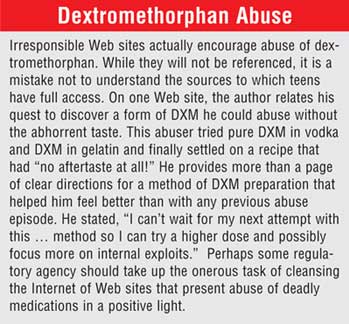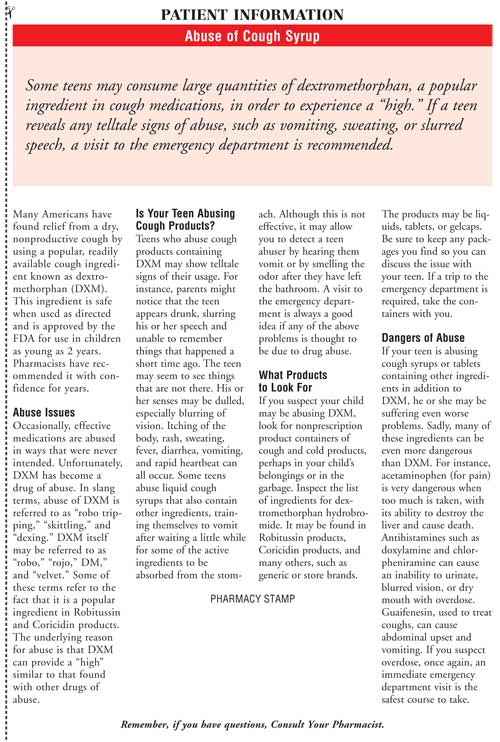US Pharm. 2006;11:10-15.
The recent law controlling sales of
pseudoephedrine products, as discussed in last month's column, is widely
hailed as a groundbreaking effort to control the availability of
methamphetamine. However, other nonprescription drugs are also widely abused,
such as dextromethorphan (DXM). Teens and adults often abuse DXM for its
purported benefits; irresponsible Web sites even provide tips for abusing and
dosing DXM and recipes to increase its palatability. Furthermore, the issue of
its safety in infants has resurfaced.
DXM Abuse
For the past several years, pharmacists have been aware of DXM abuse through
increasing sales and a rise in shoplifting of such products as Coricidin HBP.
Both the FDA and the U.S. Department of Justice (DOJ) have issued online
warnings about abuse of DXM.1,2 The FDA's warning was issued on May
20, 2005.1 It stressed the safety of the ingredient when used as a
cough suppressant in small amounts but listed the consequences of abuse (e.g.,
brain damage, seizures, loss of consciousness, irregular heart beat, death).
The FDA also revealed the growing practice of purchasing pure DXM powder, with
the aim of encapsulating it and selling it to others. With just a few clicks
on a popular search engine, one can find two laboratories seemingly prepared
to sell pure DXM to anyone with a credit card.
The DOJ "Intelligence
Bulletin," dated October 2004, is far more detailed than the FDA Web site and
includes photographs.2 The bulletin indicated that reports of DXM
abuse had become so startling that the Drug Enforcement Administration had
begun to monitor its use and that DXM might be added to the Controlled
Substances Act, if warranted. DOJ also described legislation in Texas, North
Dakota, and California that was intended to prohibit sales of DXM to minors;
however, each law was defeated.
The DOJ bulletin described
"plateaus" with DXM abuse.2 Abusers may take the drug
orally or snort pure DXM powder. The quantity abused can range from 250 to
1,500 mg per episode (vs. a therapeutic dose of 10 to 20 mg every four hours
or 30 mg every six to eight hours). Abusers try to titrate the amount in order
to move to the desired plateau. At the first plateau, a mild inebriation
begins. The second plateau resembles alcohol intoxication, with slurring of
speech and impaired short-term memory. Mild hallucinations may begin. At the
third plateau, the abuser undergoes an altered state of consciousness with
sensory impairment, especially visual. The fourth plateau brings out-of-body
experiences, with possible loss of contact with the senses, similar to effects
seen with phencyc lidine or ketamine.
DOJ described the adverse
effects of DXM doses of 250 to 1,500 mg. The list is revealing, compared to
the plateau symptoms sought by abusers. Adverse effects include blurred
vision, pruritus, rash, sweating, fever, tachycardia, hypertension, shallow
respirations, diarrhea, toxic psychosis, violence, and coma; long-term abuse
may lead to learning and memory impairments.
More problems arise with abuse
because DXM is usually available as hydrobromide salt. While reports seldom
mention it, bromide intoxication is possible.3,4

Abuse of DXM Combination
Products
The DOJ bulletin
carefully explained the problem faced by users who ingest combination products
containing DXM. These abusers also ingest supertherapeutic and/or toxic
quantities of the additional ingredients. DOJ focused on three ingredients:
Overdoses of acetaminophen can cause hepatic damage and death;
chlorpheniramine can cause tachycardia, incoordination, seizures, and coma;
and guaifenesin can cause emesis. One multiadditive cough product, Buckley's
Mixture, includes such odd ingredients as camphor, ammonium carbonate, Canada
balsam, menthol, pine needle oil, and tincture of capsicum. Many of these
products have no FDA-approved oral use, and the effects of oral ingestion
could be devastating. Abusers who choose a medication with this mix of
unapproved ingredients risk unknown and potentially deadly sequelae.
Apparently, some abusers are
aware of the dangers of the additional ingredients, engaging in a practice
known as the "robo shake."2 After ingesting large
amounts of DXM cough syrup combinations, they induce vomiting, hoping that
they have absorbed sufficient DXM to reach the desired plateau while expelling
the toxic ingredients. The fallacy in this strange practice is that absorption
of all ingredients occurs simultaneously. Thus, the user still risks toxicity
from the other active ingredients. Some abusers, however, have discovered and
shared chemical methods to extract DXM from cough syrups.
Obtaining DXM for Abuse
Purposes
The DOJ described
widespread availability of DXM at raves or other locations where young adults
gather.2 It may be sold with the understanding that the purchaser
is receiving MDMA (ecstasy), heroin, or ketamine.2 If DXM and MDMA
are used simultaneously, deadly hyperthermia may occur. The DOJ also stressed
that one of the most frequently abused products is Coricidin HBP Cough & Cold,
as it contains 30 mg of DXM per red tablet. It is referred to as "triple C,"
in reference to the three C's imprinted on the tablets. Other names
include "skittles," "dex," "candy," "red hots," and "red devils." The DOJ also
pointed out that Robitussin DM is a popular choice because its DXM content is
2 mg/mL.
Case Studies of DXM Abuse
The DOJ provided
several instances of DXM abuse. In one case, a 14-year-old Colorado boy tried
to cross a highway under the influence of DXM.2 Two cars hit him,
and he subsequently died. Investigators hypothesized that visual problems
caused him to misjudge the time he would have to cross the road. Abuse of DXM
powder caused two deaths--a suicide and an unintentional overdose.2
Two related abuse cases
provided another example of the dangers of DXM abuse.5 Two
12-year-old girls shoplifted several boxes of Coricidin Cough & Cold, each
reportedly containing 30 mg of DXM and 4 mg of chlorpheniramine. One of the
girls admitted later that she had been abusing DXM for the past 12 months,
while the other had a history of intermittent cannabis use. They ingested
eight geltabs each before going into a movie theater; a few minutes later,
they decided to empty the box and took another eight apiece. One girl vomited
30 minutes later, and the other vomited five times. After the movie, one of
the girls engaged in laughter at inappropriate times and admitted abuse to her
parents. Both girls were taken to an emergency department. They experienced
lateral nystagmus, and physicians also reported minimally reactive pupils, dry
oral mucosa, facial flushing, and the appearance of mild illness. A screening
test for drugs of abuse was negative in both girls. Both recovered after being
given intravenous fluids.
Another case illustrates the
toxicity dangers from DXM combinations.6 A 16-year-old honor roll
student had used Coricidin HBP Cough & Cold to get high many times, but over
one 72-hour period, she took 50 tablets of Coricidin HBP Maximum Strength Flu.
In the emergency department, it was found that acetaminophen had significantly
damaged her liver. She was given oral N-acetylcysteine but developed
manifestations of severe liver compromise. As her condition continued to
deteriorate, she was evaluated for a liver transplant. Eventually, she
improved, and a transplant was not needed.
The DOJ bulletin stated that
DXM was not yet proven to be addictive, but it did cause withdrawal cravings
in some abusers.2 In one case, a 16-year-old asked his mother for
help with his DXM addiction.7 He had begun drinking DXM cough syrup
from the family medicine cabinet in a quantity of one bottle per episode. The
unpleasant taste and relatively low concentration (15 mg/dose) spurred him to
graduate to Coricidin HBP Cough & Cold. He also discovered that he could more
easily carry the tablets to school surreptitiously. Being able to take tablets
containing 30 mg each allowed him to meet the accelerating demands of
tolerance that are characteristic of other addictions. He coined a term,
"sheeting," for his practice of ingesting one full "sheet" of 16 tablets per
episode.
DXM abuse is not limited to
teens. A 66-year-old recovering alcoholic despondent over marital difficulties
discovered that DXM cough syrup produced euphoria resembling alcohol addiction.
4 She began DXM abuse with an occasional 4-oz bottle of store-brand
DXM/guaifenesin mixture, graduating to a maximum consumption of 16 oz daily
(equivalent to 960 mg of DXM). Three days after halting the abuse, she
presented to physicians with sharp epigastric abdominal pain, nausea/vomiting,
hand tremors, depression, dysphoria, and insomnia. Given withdrawal support,
she eventually recovered from her addiction.
DXM Administration to
Babies
The minimum
FDA-approved age for self-care with DXM is 2 years. One company has circulated
pediatric dosing charts to pharmacists.8 The sheets include nine
popular DXM-containing products, each of which has dosing directions for
infants as young as 6 months. Some products also contain acetaminophen,
pseudoephedrine, and/or guaifenesin, all with lower age cutoffs of 2 years.
Some products also include chlorphen iramine, not known to be safe for
self-care in patients younger than 6. These doses are not FDA approved as safe
in those ages in self-care situations. The references are two textbooks and
the USP-DI 2001. It is not known whether these doses resulted from
well-designed, placebo-controlled, double-blinded trials in babies or whether
they result from guesswork. If they are research-based, they should be
submitted to the FDA to be evaluated and eventually approved for use. Until
the FDA approves these doses, pharmacists should be cautious in recommending
them for infants.
Pharmacy Solutions
The DOJ stated that
some pharmacies voluntarily moved DXM products behind the counter to prevent
shoplifting and potential abuse.2 Other pharmacies have instituted
sales limits. If the widespread abuse continues unchecked, it may be
appropriate for regulatory authorities to consider limiting sales to
behind-the-counter status, much like what the 2005 Combat Methamphetamine
Epidemic Act did for pseudoephedrine sales. While the industry would likely
oppose this move, it may require swift legal action to help check the epidemic
of DXM abuse.
REFERENCES
1. FDA warns
against abuse of dextromethorphan (DXM). Food and Drug Administration.
Available at: www.fda.gov/bbs/topics/ANSWERS/2005/ANS01360.html. Accessed
September 8, 2006.
2. Intelligence
bulletin: DXM (dextromethorphan). United States Department of Justice.
Available at: www.usdoj.gov/ndic/pubs11/11563/index.htm. Accessed September 8,
2006.
3. Hung YM. Bromide
intoxication by the combination of bromide-containing over-the-counter drug
and dextromethorphan hydrobromide. Hum Exp Toxicol. 2003;22:459-461.
4. Desai S, Aldea D,
Daneels E, et al. Chronic addiction to dextromethorphan cough syrup: a case
report. J Am Board Fam Med. 2006;19:320-323.
5. Boyer EW.
Dextromethorphan abuse.Pediatr Emerg Care. 2004;20:858-863.
6. Kirages TJ, Sule HP,
Mycyk MB. Severe manifestations of Coricidin intoxication. Am J Emerg Med
. 2003;21:473-475.
7. Miller SC. Coricidin
HBP cough and cold addiction. J Am Acad Child Adolesc Psychiatry.
2005;44:509-510.
8. Recommend the relief
that's right for every patient. Wyeth Consumer Healthcare. 2005.
To comment on this article, contact
editor@uspharmacist.com.







